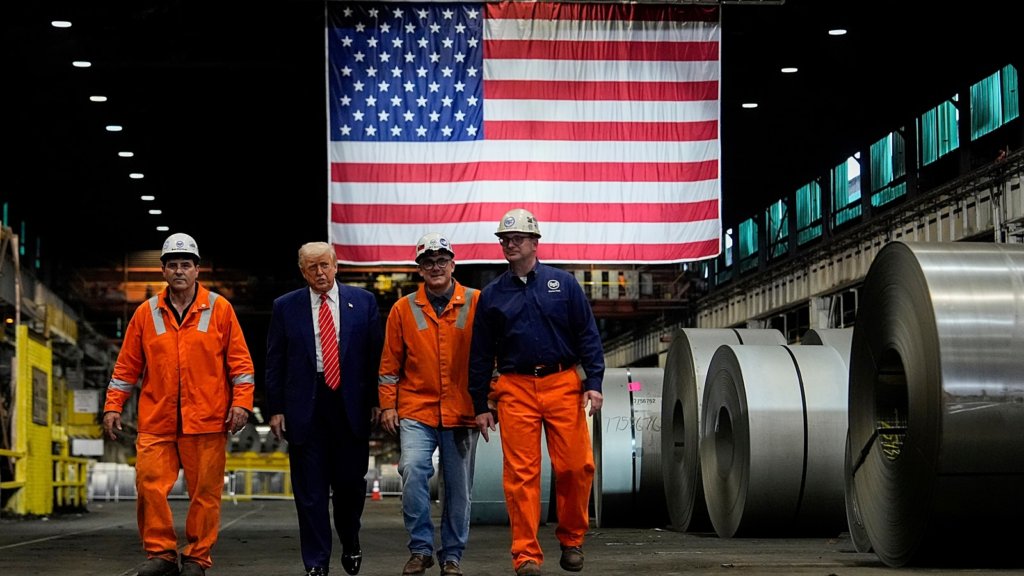In a move shaking global markets and sparking political debate, former U.S. President Donald Trump announced a 50% tariff on steel imports, doubling the previous rate. The announcement, framed as a national security measure, has already started impacting industries across the United States and abroad.
Why Did Trump Raise Steel Tariffs?
During a press conference, Donald Trump emphasized that the decision to raise tariffs is about protecting America’s industrial core. He stated, “A strong steel industry is vital for national security. We can’t depend on foreign steel when it comes to building our ships, tanks, and infrastructure.”

The decision comes amid rising global tensions, and Trump’s camp argues the U.S. must become more self-reliant in producing materials critical to defense and infrastructure.
This is not the first time Trump has used Section 232 of the Trade Expansion Act, which allows the president to impose tariffs for national security reasons. He previously invoked this same section in 2018 when he first levied a 25% tariff on steel and 10% on aluminum imports.
Learn more about Section 232 here
Economic Impact: Boost or Burden?
Trump’s decision has sparked mixed reactions. American steel producers have welcomed the move, claiming it will help revive a struggling industry and save jobs.
John Ferris, CEO of SteelWorks USA, said, “We’ve been pushed to the edge by cheap imports from China and other countries. This gives us a fighting chance.”
However, economists warn of unintended consequences. Industries that rely heavily on steel—like construction, auto manufacturing, and machinery—are likely to face higher costs. These increased production costs could be passed on to consumers in the form of price hikes.
Global Backlash and Trade Relations
Unsurprisingly, global reactions have been critical. The European Union, Canada, and Mexico—key steel exporters to the U.S.—have condemned the move and are considering counter-tariffs. China, which has long been at the center of U.S. trade policy debates, is also expected to challenge the decision at the World Trade Organization (WTO).
More on U.S.–China trade relations here
Many analysts believe this move could spark a new round of trade wars, potentially harming the broader global economy. Trade lawyer Sarah Rothman noted, “Tariffs like these are rarely one-sided. Retaliation from other nations can lead to escalated trade disputes.”
Political Reactions Within the U.S.
Trump’s announcement has caused ripples across the American political landscape. Republican lawmakers aligned with the former president praised the move, calling it a bold stance for American manufacturing. Senator Josh Hawley tweeted, “We need to bring back American industry. President Trump gets it.”
On the other hand, Democrats and some moderate Republicans criticized the decision, stating that it could lead to job losses in other sectors and increase inflationary pressure.
A Look at the Steel Industry Today
The U.S. steel industry has been in decline for decades due to global competition and automation. While it still produces over 80 million metric tons annually, much of the domestic need is met through imports, which tend to be cheaper.
These imports have often been accused of dumping, where foreign producers sell steel at below-market prices to undercut American competitors. Trump’s administration argues that without strong tariffs, U.S. producers simply can’t compete.
Detailed report on global steel dumping here
What It Means for American Consumers
Higher tariffs mean higher raw material costs. This is likely to trickle down into the cost of consumer goods, from automobiles to household appliances. Economists predict a modest increase in prices for end-users in the coming months.

Construction companies, in particular, are expected to feel the squeeze. With steel prices already high due to global inflationary trends, the additional tariff could delay infrastructure projects and raise housing costs.
The Road Ahead
Whether or not the 50% tariff will deliver long-term benefits remains uncertain. Critics argue that protectionist policies like this provide short-term relief but don’t address deeper structural issues within the American manufacturing sector—like the need for modernization, workforce retraining, and innovation.
Still, Trump has doubled down on his stance. “We’ve seen what happens when we outsource everything,” he said. “America First means American steel.”
His words echo a broader political message aimed at rallying blue-collar voters and reinforcing his economic nationalism platform ahead of upcoming elections.
Final Thoughts
The steel tariff increase to 50% marks a significant moment in U.S. trade and industrial policy. While it may offer a short-term boost to domestic producers, the long-term effects—on jobs, prices, and global relations—remain to be seen.
As businesses, consumers, and policymakers brace for the ripple effects, one thing is clear: steel has once again become a symbol of America’s economic identity and political struggle.
Track updates on U.S. steel policy here
Also Read – Who Will Lead Buffalo? Key Details on 2025 Mayoral Election






